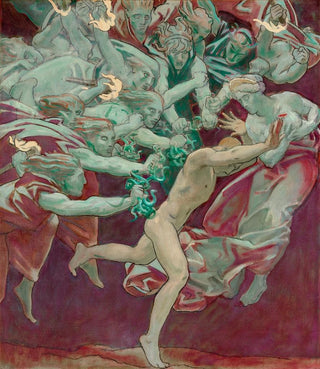Art print | Oreste and the Furies - John Singer Sargent


View from behind

Frame (optional)
In the vast panorama of art history, some works stand out for their ability to capture intense emotions and mythological narratives. "Oreste et les Furies" by John Singer Sargent is undoubtedly one of these remarkable creations. This painting depicts a poignant scene from Greek mythology, where the hero Oreste, overwhelmed by the vengeance of the Furies, confronts his own inner demons. Sargent, with his inimitable style, manages to combine the dramatic power of the story with technical mastery that leaves the viewer captivated. The art print of this piece allows for an exploration of the depths of the human soul while offering an immersion into the refined aesthetics of the artist.
Style and uniqueness of the work
The uniqueness of "Oreste et les Furies" lies in how Sargent plays with light and shadow to create an atmosphere charged with tension. The choice of colors, oscillating between dark tones and flashes of light, enhances the drama of the scene. The figures, rendered with remarkable precision, seem almost alive, their expressions revealing a range of emotions from fear to despair. Sargent does not merely depict a mythological scene; he plunges us into the heart of an inner conflict, illustrating the individual's struggle against uncontrollable forces. This painting, through its dynamic composition and bold use of color, highlights Sargent's virtuosity as a portraitist and storyteller.
The artist and his influence
John Singer Sargent, often associated with Impressionism, transcended the limits of that movement to create a style that is uniquely his own. Born in 1856, this American artist was influenced by his travels in Europe and by the masters of classical painting. His ability to capture light and textures made him a renowned portraitist, but it is in works like "Oreste et les Furies" that he demonstrates his interest in darker, psychological themes. Sargent successfully integrated elements of mythology into his work, reinterpreting ancient stories to make them accessible

Matte finish

View from behind

Frame (optional)
In the vast panorama of art history, some works stand out for their ability to capture intense emotions and mythological narratives. "Oreste et les Furies" by John Singer Sargent is undoubtedly one of these remarkable creations. This painting depicts a poignant scene from Greek mythology, where the hero Oreste, overwhelmed by the vengeance of the Furies, confronts his own inner demons. Sargent, with his inimitable style, manages to combine the dramatic power of the story with technical mastery that leaves the viewer captivated. The art print of this piece allows for an exploration of the depths of the human soul while offering an immersion into the refined aesthetics of the artist.
Style and uniqueness of the work
The uniqueness of "Oreste et les Furies" lies in how Sargent plays with light and shadow to create an atmosphere charged with tension. The choice of colors, oscillating between dark tones and flashes of light, enhances the drama of the scene. The figures, rendered with remarkable precision, seem almost alive, their expressions revealing a range of emotions from fear to despair. Sargent does not merely depict a mythological scene; he plunges us into the heart of an inner conflict, illustrating the individual's struggle against uncontrollable forces. This painting, through its dynamic composition and bold use of color, highlights Sargent's virtuosity as a portraitist and storyteller.
The artist and his influence
John Singer Sargent, often associated with Impressionism, transcended the limits of that movement to create a style that is uniquely his own. Born in 1856, this American artist was influenced by his travels in Europe and by the masters of classical painting. His ability to capture light and textures made him a renowned portraitist, but it is in works like "Oreste et les Furies" that he demonstrates his interest in darker, psychological themes. Sargent successfully integrated elements of mythology into his work, reinterpreting ancient stories to make them accessible






